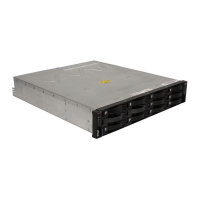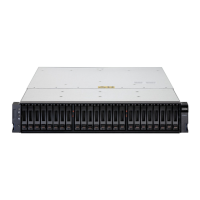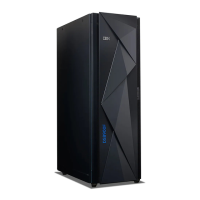7065Admin_Configure.fm Draft Document for Review August 30, 2007 12:59 am
172 IBM System Storage DS3000: Introduction and Implementation Guide
If a data block on the base logical drive is modified, a copy-on-write occurs first, which copies
g the contents of blocks that are to be modified into the FlashCopy repository logical drive, for
safekeeping. Subsequently, the corresponding pointer in the metadata database changes.
Since the FlashCopy repository logical drive stores copies of the original data in those data
blocks, further changes to those data blocks write directly to the base logical drive without
another copy-on-write. And, since the only data blocks that are physically stored in the
FlashCopy repository logical drive are those that have changed since the time of the
FlashCopy, the FlashCopy technology uses less disk space than a full physical copy.
When you create a FlashCopy logical drive, you specify where to create the FlashCopy
repository logical drive, its capacity, warning threshold, and other parameters. You can
disable the FlashCopy when you are finished with it, for example, after a backup completes.
The next time you re-create the FlashCopy, it reuses the existing FlashCopy repository logical
drive. Deleting a FlashCopy logical drive will also delete the associated FlashCopy repository
logical drive.
8.4.2 Estimating FlashCopy repository logical drive capacity
The FlashCopy repository logical drive is created to store FlashCopy metadata (data about
the FlashCopy) and any copy-on-write data needed during the life of the FlashCopy logical
drive. By default the FlashCopy repository logical drive’s capacity is 20% of the base logical
drive's capacity. In general, this capacity should be sufficient. However, you can use the
following information to help determine the appropriate capacity of the FlashCopy repository
logical drive:
A FlashCopy repository logical drive must be at least 8 MB.
Set a larger percentage if a large percentage of data blocks will change on the base
logical drive during the life of the FlashCopy logical drive.
Set a larger percentage if you need to keep the FlashCopy logical drive for a longer period.
Calculating expected overhead
Normally, the default setting will be sufficient. You will see a warning when the FlashCopy
repository logical drive reaches a certain percentage full. You can increase its capacity using
the Logical Drive → Increase Capacity option in Storage Manager.
Use the following formula to calculate the amount of management overhead required to store
FlashCopy data on the FlashCopy repository logical drive. This formula should be used
merely as a guide, and FlashCopy repository logical drive capacity should be re-estimated
periodically.
The formula to calculate the amount of management overhead required is:
192 KB + (X/2000)
Here, X is the capacity of the base logical drive in bytes.
Example
For a 5 GB base logical drive, where 30% of the data blocks are expected to change on the
base logical drive, the estimated FlashCopy repository logical drive capacity can be
calculated as follows:
1. Convert the base logical drive's capacity to bytes.
Note: To use this formula, you need to convert from bytes to kilobytes, and then to
megabytes.

